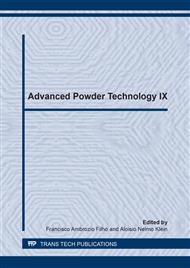p.452
p.457
p.462
p.467
p.472
p.477
p.483
p.491
p.496
Comparative Study of Creep Resistance of a Ti-6Al-4V Alloy with Metallic and Ceramic Coatings
Abstract:
Titanium and its alloys are largely used for many industrial applications due to their high mechanical and corrosion resistance and low specific mass. Ti-6Al-4V alloy is the most used in aerospace industry and it is applied for the manufacturing of aircraft blades and steam turbines. This alloy has high affinity with oxygen which constrains its application at high temperatures due to creep resistance reduction. Methods to increase creep resistance of Ti-6Al-4V alloys includes the use of metallic coatings and its combination with ceramic thermal barrier coating deposition on the material surface. The aim of this work is to compare the creep behavior of Ti-6Al-4V alloy in three different conditions: uncoated, metallic coated, metallic + ceramic coated specimens. The metallic coating layer (CoNiCrAlY) and the ceramic coating (ZrO2 + 8wt%Y2O3) are both applied by plasma spray deposition technique. The specimens were submitted to constant load creep tests at 600oC and stress conditions of 125, 250 and 319MPa. Specimens of metallic + ceramic coating have presented higher creep resistance, longer lifetime and lower stationary creep rate when compared to uncoated and metallic coated specimens.
Info:
Periodical:
Pages:
472-476
Citation:
Online since:
December 2014
Keywords:
Price:
Сopyright:
© 2014 Trans Tech Publications Ltd. All Rights Reserved
Share:
Citation:


